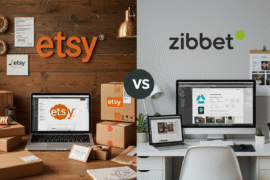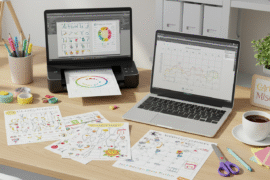This article may contain references to products or services from one or more of our advertisers or partners. We may receive compensation when you click on links to those products or services. Nonetheless, our opinions are our own.
Are you passionate about personal finance and looking for a creative outlet to share your knowledge and insights with others? Starting a personal finance blog could be the perfect solution! Blogging not only allows you to express your ideas and connect with like-minded people, but it can also provide you with opportunities to monetize your content and turn your passion into a profitable business. In this article, we’ll walk you through the essential steps of starting a personal finance blog and share some tips to help you create engaging content that resonates with your readers.
Step 1: Define Your Niche and Target Audience
Understanding Your Personal Finance Blog’s Niche
Before you start creating content for your blog, it’s important to define your niche. Personal finance is a broad topic, and by narrowing down your focus, you’ll be able to establish yourself as an expert in your field and attract a more targeted audience. But before you start registering your domain, it’s better to register a company first, house the blog inside this company, and tie the blog’s profits and losses into a limited liability structure so your own personal finances are secure in case the blog’s runs up a loss.
Here are some examples of niches within the personal finance blogging space:
- Budgeting and saving
- Investing and retirement planning
- Debt management and credit repair
- Streamline Your Personal Finances with online invoicing
- Frugal living and minimalism
- Side hustles and entrepreneurship
- Defining Your Target Audience
Once you’ve identified your niche, the next step is to determine your target audience for good SEO. Who are you writing for? What are their demographics, interests, and pain points?
It takes a normal seo service to a professional seo service, to do this right.
One of the main reasons why brand identity is important is that it helps businesses build trust and credibility with their audience and the brand identity is the best place to advertise your business.
By understanding your audience’s needs and preferences, you’ll be able to create content that resonates with them and keeps them coming back for more. Some questions to consider when defining your target audience include:
- What age group do they belong to?
- What is their income level?
- Do they run a business or work for a company? Or are they self-employed and work for platforms, such as Fiverr vs Upwork vs freelancer?
- What are their financial goals and challenges?
- What topics are they interested in learning more about?
- How many times do they eat out per week?
- Do they visits restaurants nearby or go out of their way with coupons to different restaurants?
Step 2: Choose a Domain Name and Web Hosting
Your domain name is your blog’s online identity, so it’s essential to choose a name that reflects your brand and is easy to remember. Ideally, your domain name should be short, catchy, and relevant to your niche.
Once you’ve chosen your domain name, you’ll need to select a web hosting provider. A web host is a service that stores your website’s files and makes it accessible to visitors on the internet. When choosing a web host, consider factors such as uptime, security (e.g., SSL monitoring for certificate validity), and customer support.
Step 3: Set Up Your Blog
Selecting a Content Management System (CMS)
A content management system (CMS) is a software platform that allows you to create, edit, and publish content on your blog. There are many CMS options available, but WordPress is the most popular choice among bloggers due to its flexibility and user-friendly interface.
Choosing a Theme
A theme is a pre-designed template that determines the look and feel of your site.
Step 4: Create Compelling Content
Developing a Content Strategy
To build a successful blog, you need to create content that engages and informs your audience. A content strategy is a plan that outlines what type of content you’ll create, how often you’ll publish, and how you’ll promote your content. A great piece of content always requires great visuals and you can do the same with procreate cartoon brushes.
Personalization and Customization: Customers appreciate personalized experiences. Implement strategies that allow you to personalize your marketing messages and offerings based on individual customer preferences. Utilize customer data and analytics to understand their behavior and preferences, and provide tailored recommendations and offers. This level of customization enhances customer engagement rate and increases the likelihood of people finding your content to be useful.
When developing your content strategy, consider your niche, target audience, and goals. What topics will you cover? Will you focus on long-form articles, infographics, videos, or podcasts? How often will you publish new content? How will you measure the success of your content?
Crafting Your First Blog Post
Your first blog post sets the tone for your blog, so it’s essential to make it informative, engaging, and well-written. Here are some tips to help you craft a compelling first post:
- Choose a captivating headline: Your headline should grab your readers’ attention and entice them to read further. Use numbers, emotional words like Grammarly free trial or discount, and action verbs to make your headline stand out.
- Start with a hook: Your introduction should hook your readers and make them want to keep reading. Share a personal story, ask a question, or make a bold statement to draw them in.
- Provide valuable information: Your readers are looking for solutions to their financial problems, so make sure your post provides useful tips, insights, or resources. Use clear, concise language and avoid jargon or technical terms.
- Use visuals: Incorporating images, charts, or infographics can make your post more engaging and easier to understand. Use high-quality visuals, increasing the resolution via image upscaling if necessary, that relate to your content and provide additional value to your readers.
- End with a call to action: Your post should have a clear purpose, whether it’s to educate, inspire, or motivate your readers. End with a call to action that encourages them to share your post, leave a comment, or sign up for your email list.
Incorporating Visuals into Your Blog Posts
Visuals can help your blog posts stand out and make them more engaging for your readers. Here are some ways to incorporate visuals into your content:
- Use images: Adding relevant images to your post can help break up the text and make it more visually appealing. Choose high-quality images that relate to your content and optimize them for web use to avoid slowing down your website. Use an AI image generator to get custom, branded images for your posts.
- Create infographics: Infographics are a popular way to present complex information in a visually appealing format. Use online tools or hire a designer to create professional-looking infographics that add value to your content.
- Embed videos: Videos can provide additional information or entertainment for your readers. Create your own videos or embed relevant videos from YouTube or other sources to enhance your post.
- Use charts and graphs: If you’re discussing financial data or statistics, using charts or graphs can help your readers visualize the information and make it easier to understand.
By incorporating visuals into your blog posts, you can make your content more engaging and shareable, and ultimately attract more readers to your blog.
Step 5: Promote Your Blog
Social media is a powerful tool for promoting your blog and reaching a wider audience. Choose the platforms that are most relevant to your niche and target audience, and use them to share your blog posts, interact with your followers, and build your brand. Next, you need a tweet scheduler to create and post content to social media channels like Twitter. This will help you
Some popular social media platforms for personal finance bloggers include Twitter, Facebook, Instagram, and LinkedIn. Use hashtags, engaging captions, and eye-catching visuals to increase your visibility and follower growth. Communicate with your audience through Instagram comments or learn how to use LinkedIn Sales Navigator to acquire prospects’ email addresses, for example.
Building Your Email List
Email outreach is a cost-effective way to reach your audience and keep them engaged with your content. Offer a lead magnet, such as a free e-book or a financial planning worksheet, in exchange for your readers’ verified email addresses.
Once you’ve done these things you are partly ready.
Step 6: Monetize Your Blog
Once you’ve built a following and established your brand, you can start monetizing your blog. Here are some ways to make money from your blog:
Affiliate Marketing
Affiliate marketing is a popular sales tool to earn money by promoting products or services on your blog. You earn a commission for every sale made through your unique affiliate link after coming to an affiliate marketing agreement with the retailer.
To be successful with affiliate marketing, choose products or services that align with your niche and target audience. Promote them in a way that adds value to your readers and makes them want to buy.
Sponsored Content
Sponsored content is another way to earn money from your blog. You get paid to create content that promotes a product or service, usually in the form of a review or tutorial.
To attract sponsored content opportunities, build a strong online presence, and establish yourself as an authority in your niche. Reach out to brands that align with your values and target audience, and pitch them your ideas for sponsored content.
Display Advertising
Display advertising involves placing ads on your blog in exchange for payment. You can use ad networks like Google AdSense or work directly with advertisers to display ads on your site.
To make the most money from display advertising, optimize your site for ad placement and use ad formats that are most effective for your audience. Be careful not to clutter your site with too many ads, as this can negatively impact your user experience.
Creating and Selling Digital Products
Creating and selling digital products, such as e-books, courses, or printables, can be a lucrative way to monetize your blog. To be successful, choose products that align with your niche and provide value to your readers.
You can sell digital products on your blog using e-commerce platforms like Shopify or Gumroad. Promote your products through email marketing software,social media, and your blog posts to attract buyers.
By diversifying your income streams, you can maximize your earning potential and turn your blog into a profitable business. Remember to always prioritize your readers and provide value to them, and the money will follow.

Reviewed and edited by Albert Fang.
See a typo or want to suggest an edit/revision to the content? Use the contact us form to provide feedback.
At FangWallet, we value editorial integrity and open collaboration in curating quality content for readers to enjoy. Much appreciated for the assist.
Did you like our article and find it insightful? We encourage sharing the article link with family and friends to benefit as well - better yet, sharing on social media. Thank you for the support! 🍉
Article Title: How to Start a Personal Finance Blog: A Comprehensive Guide
https://fangwallet.com/2023/06/14/how-to-start-a-personal-finance-blog-a-comprehensive-guide/The FangWallet Promise
FangWallet is an editorially independent resource - founded on breaking down challenging financial concepts for anyone to understand since 2014. While we adhere to editorial integrity, note that this post may contain references to products from our partners.
The FangWallet promise is always to have your best interest in mind and be transparent and honest about the financial picture.
Become an Insider

Subscribe to get a free daily budget planner printable to help get your money on track!
Make passive money the right way. No spam.
Editorial Disclaimer: The editorial content on this page is not provided by any of the companies mentioned. The opinions expressed here are the author's alone.
The content of this website is for informational purposes only and does not represent investment advice, or an offer or solicitation to buy or sell any security, investment, or product. Investors are encouraged to do their own due diligence, and, if necessary, consult professional advising before making any investment decisions. Investing involves a high degree of risk, and financial losses may occur including the potential loss of principal.
Source Citation References:
+ Inspo











































